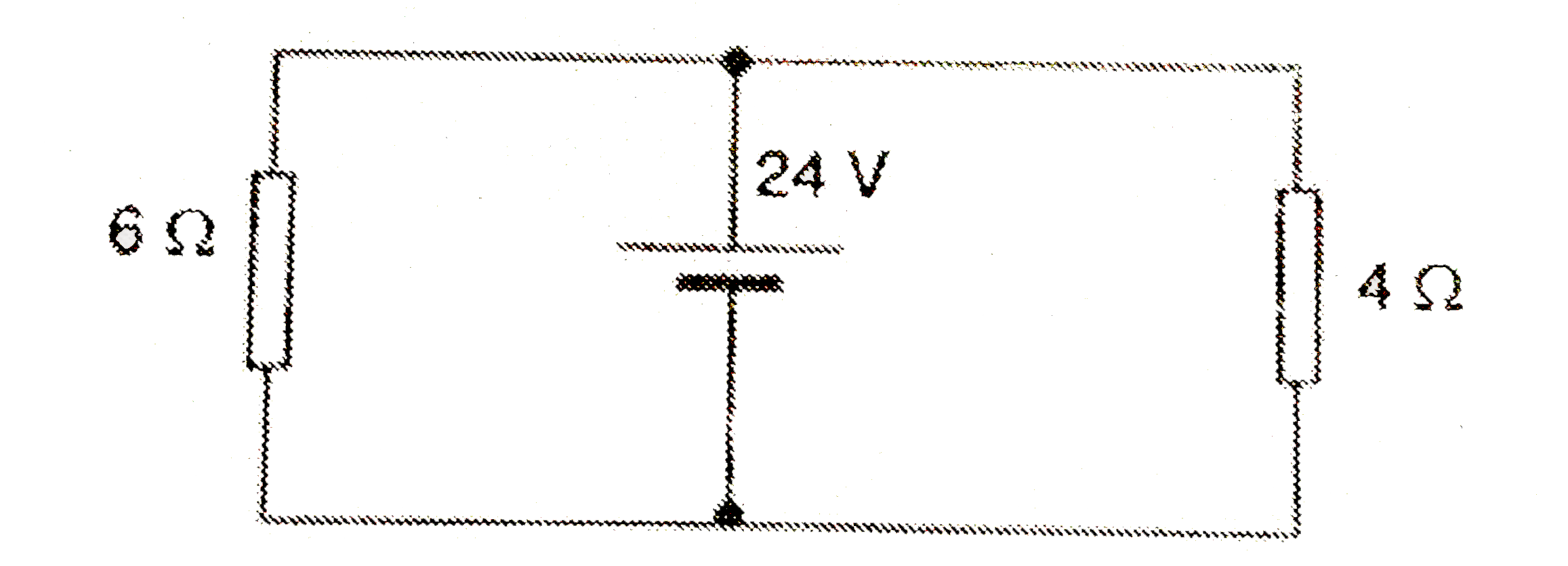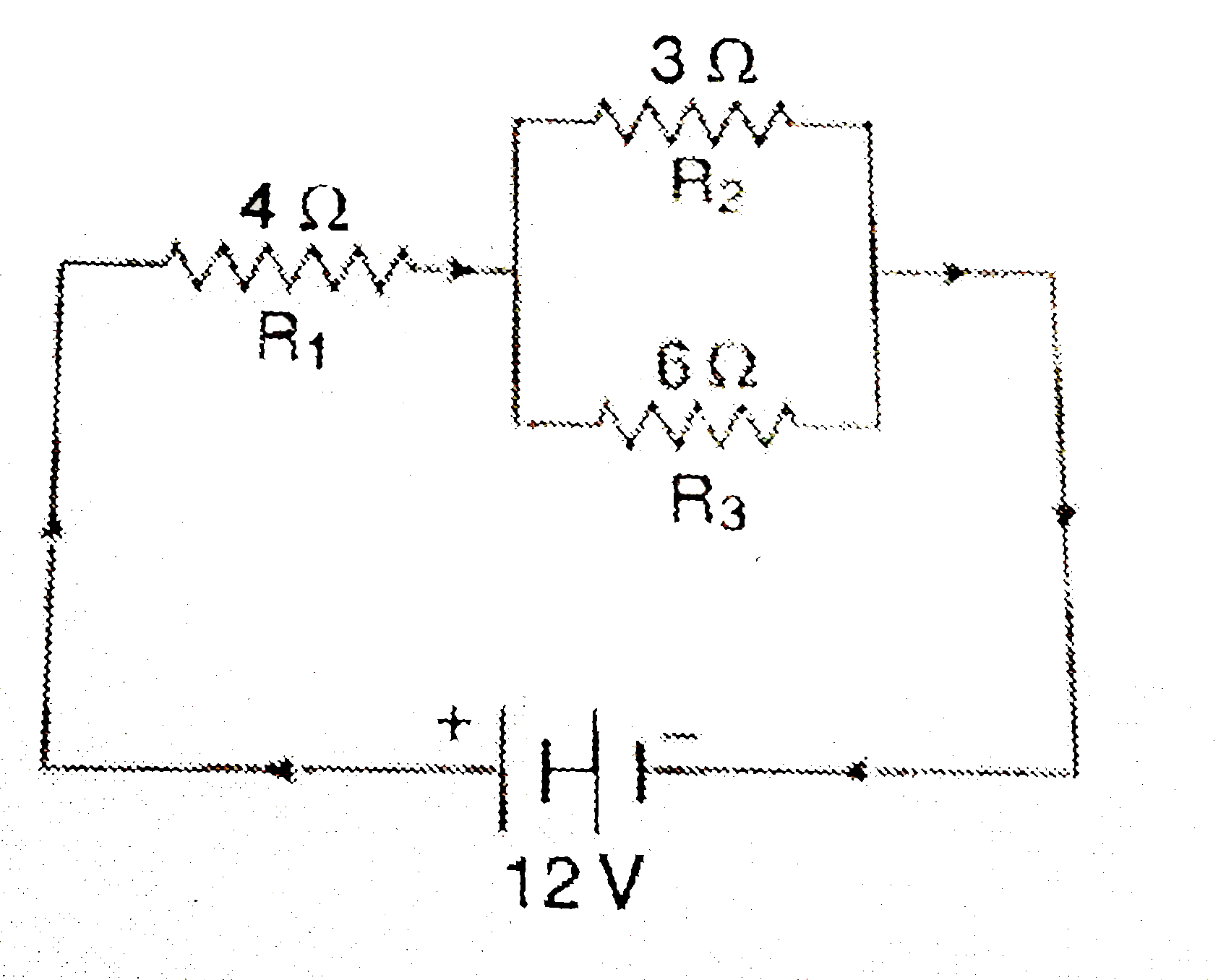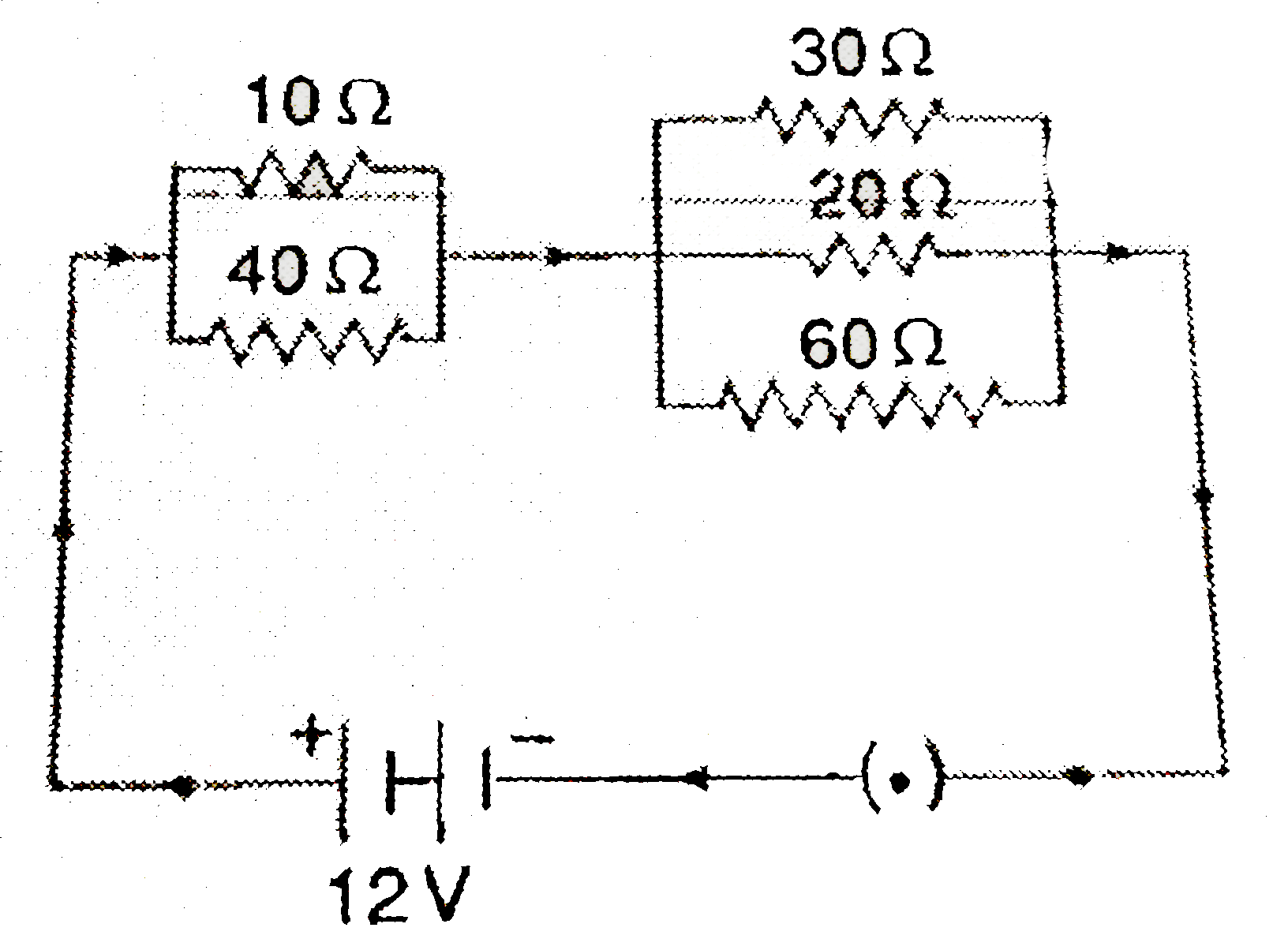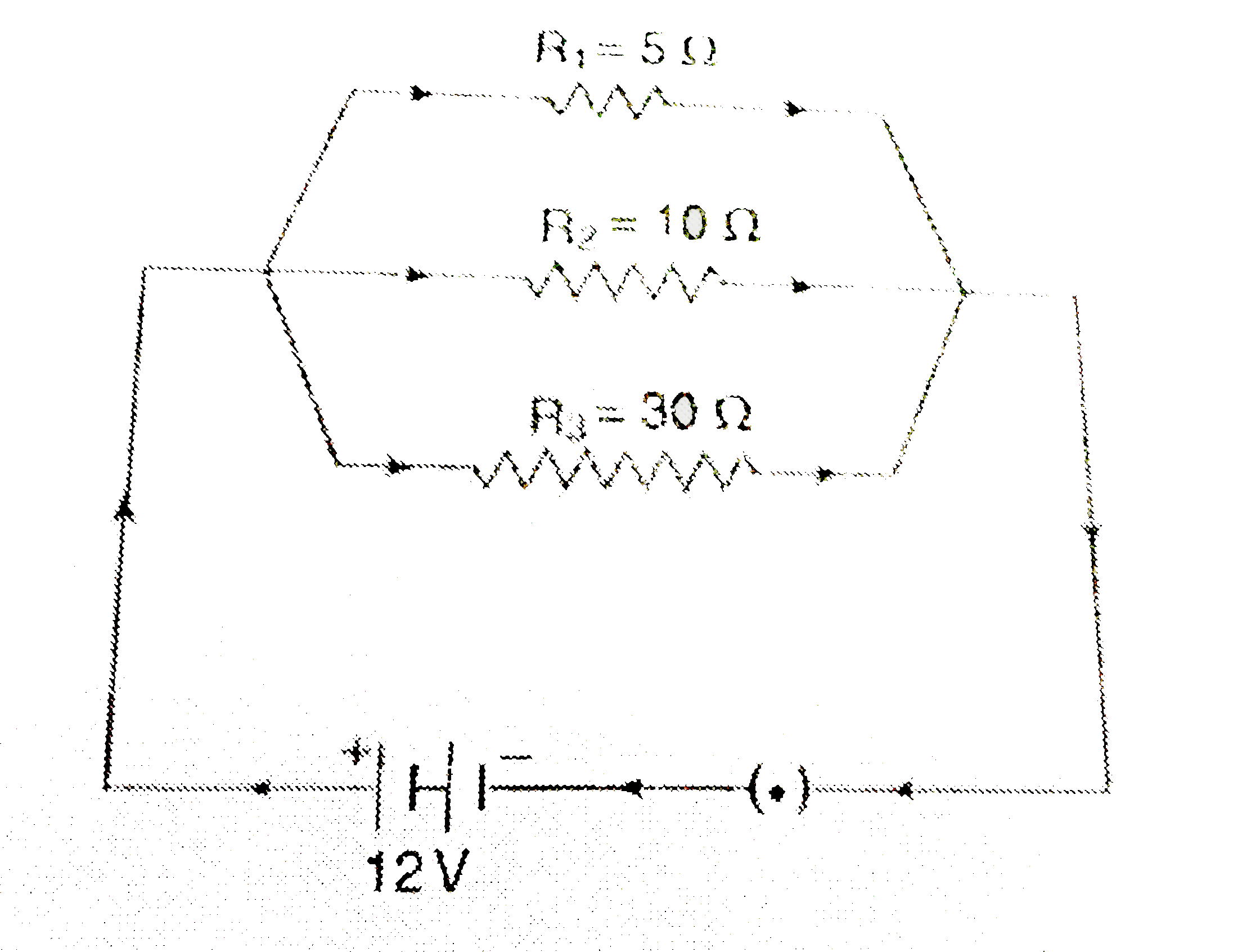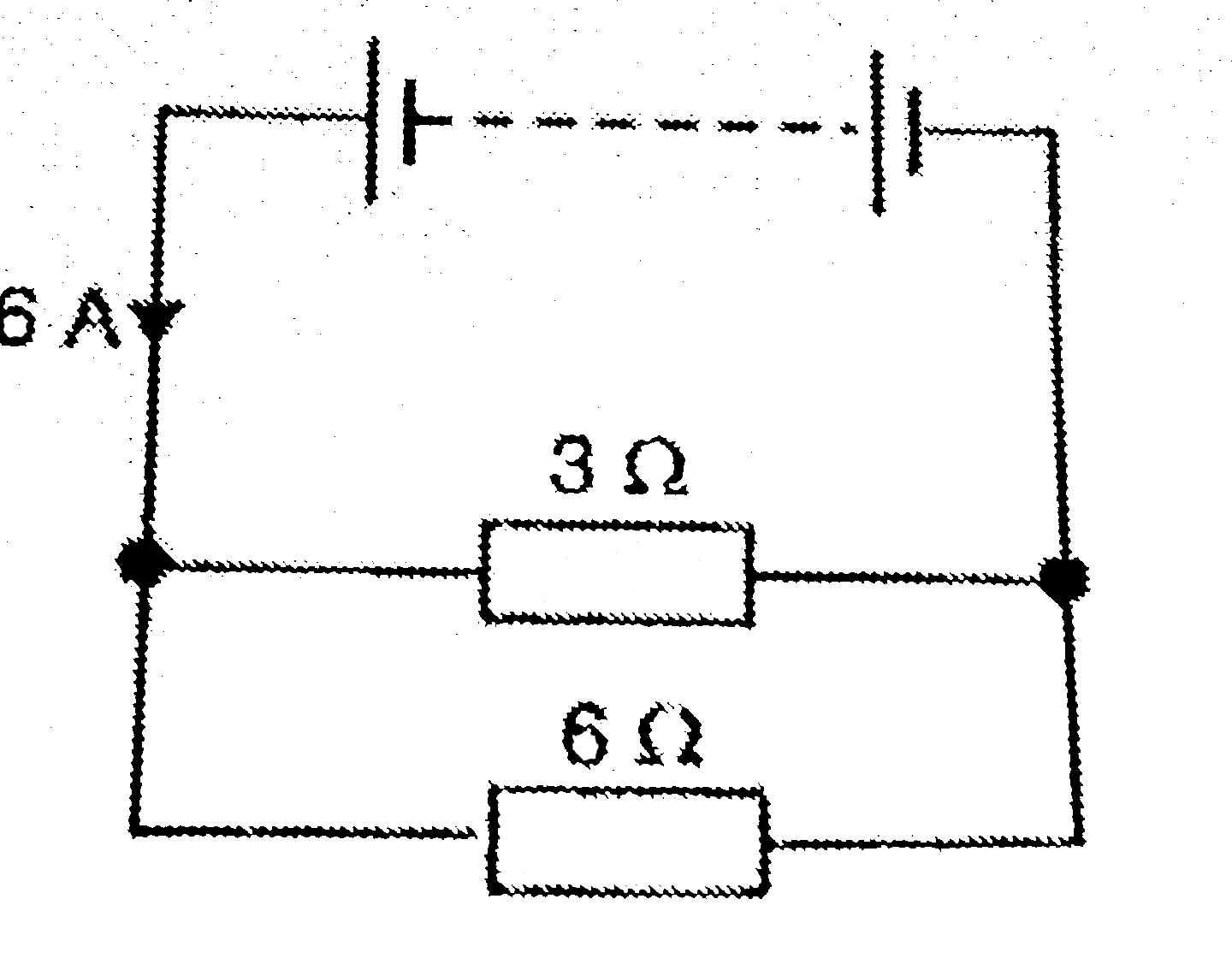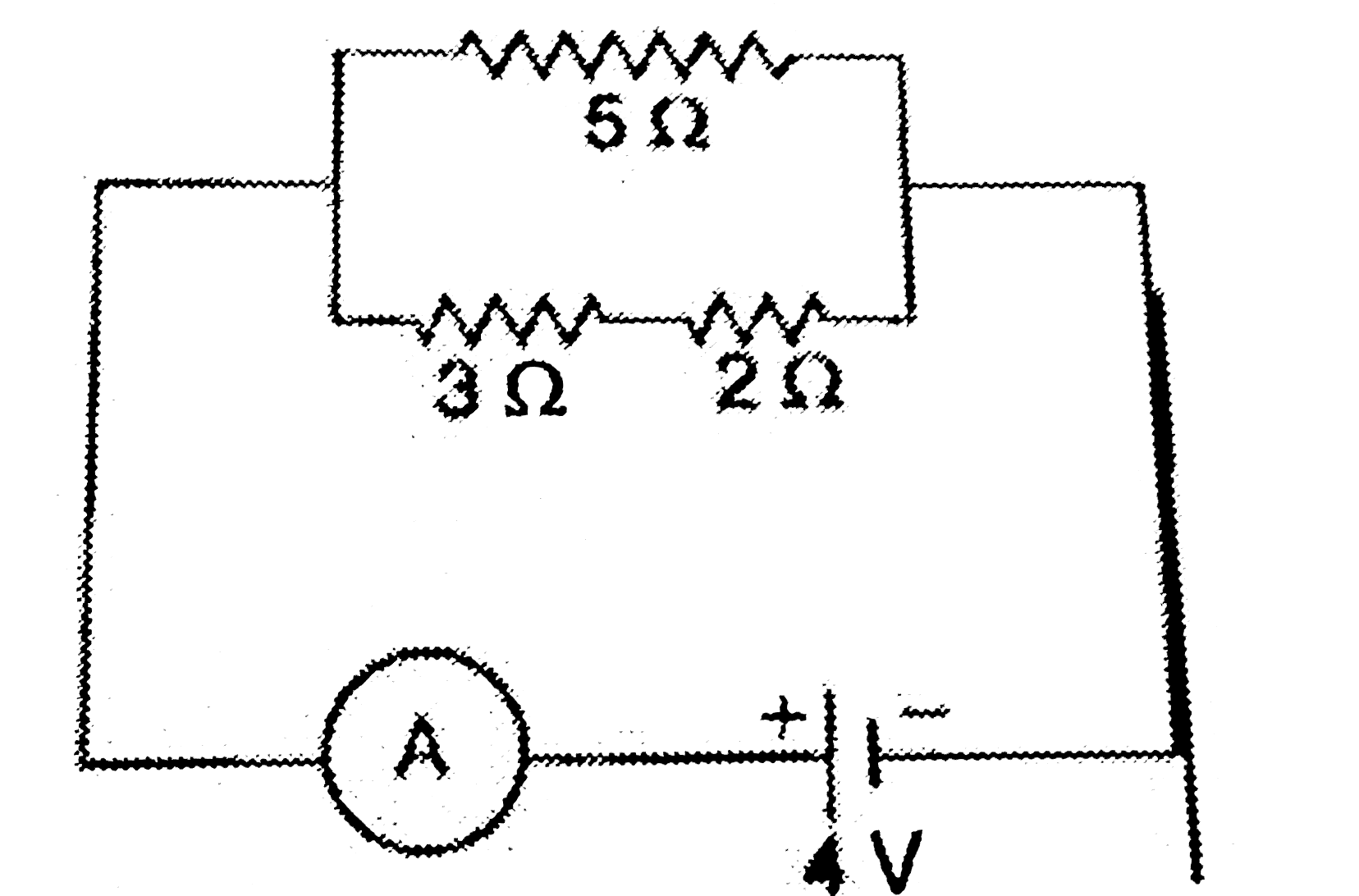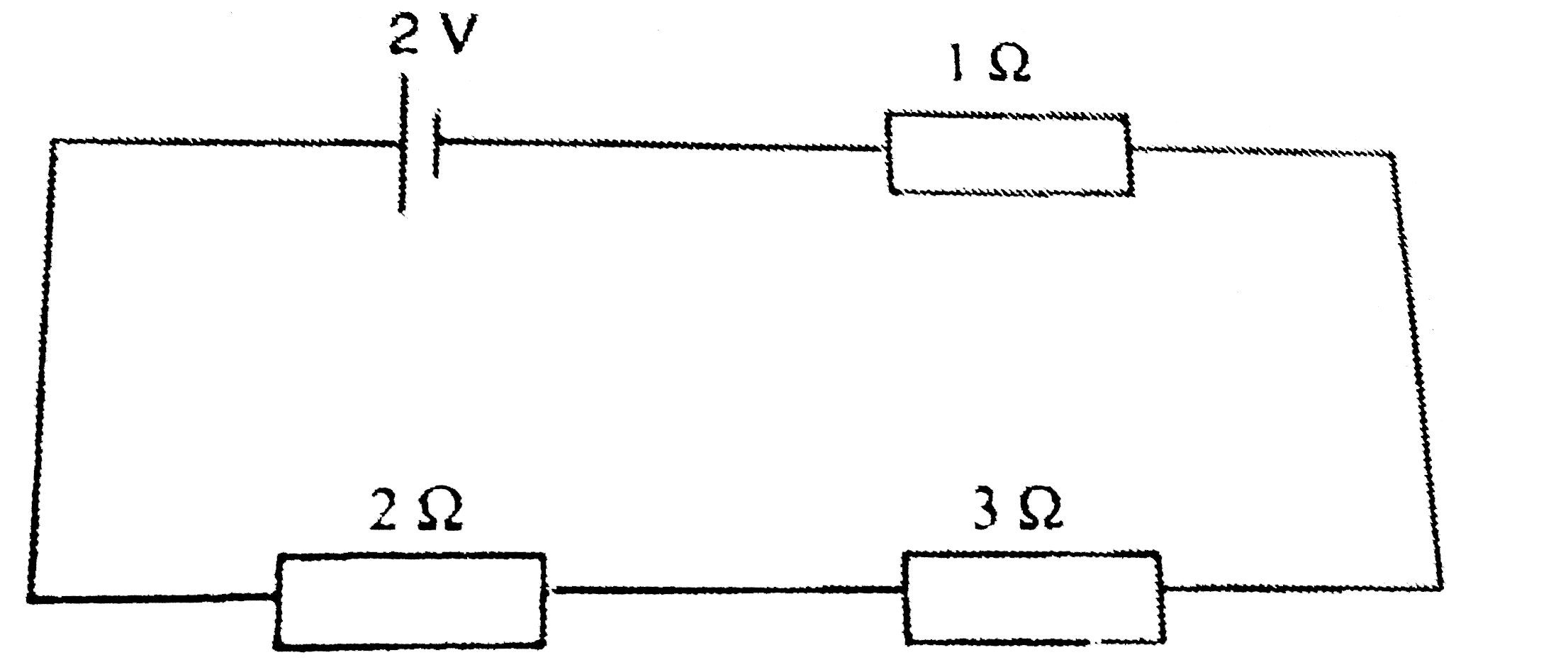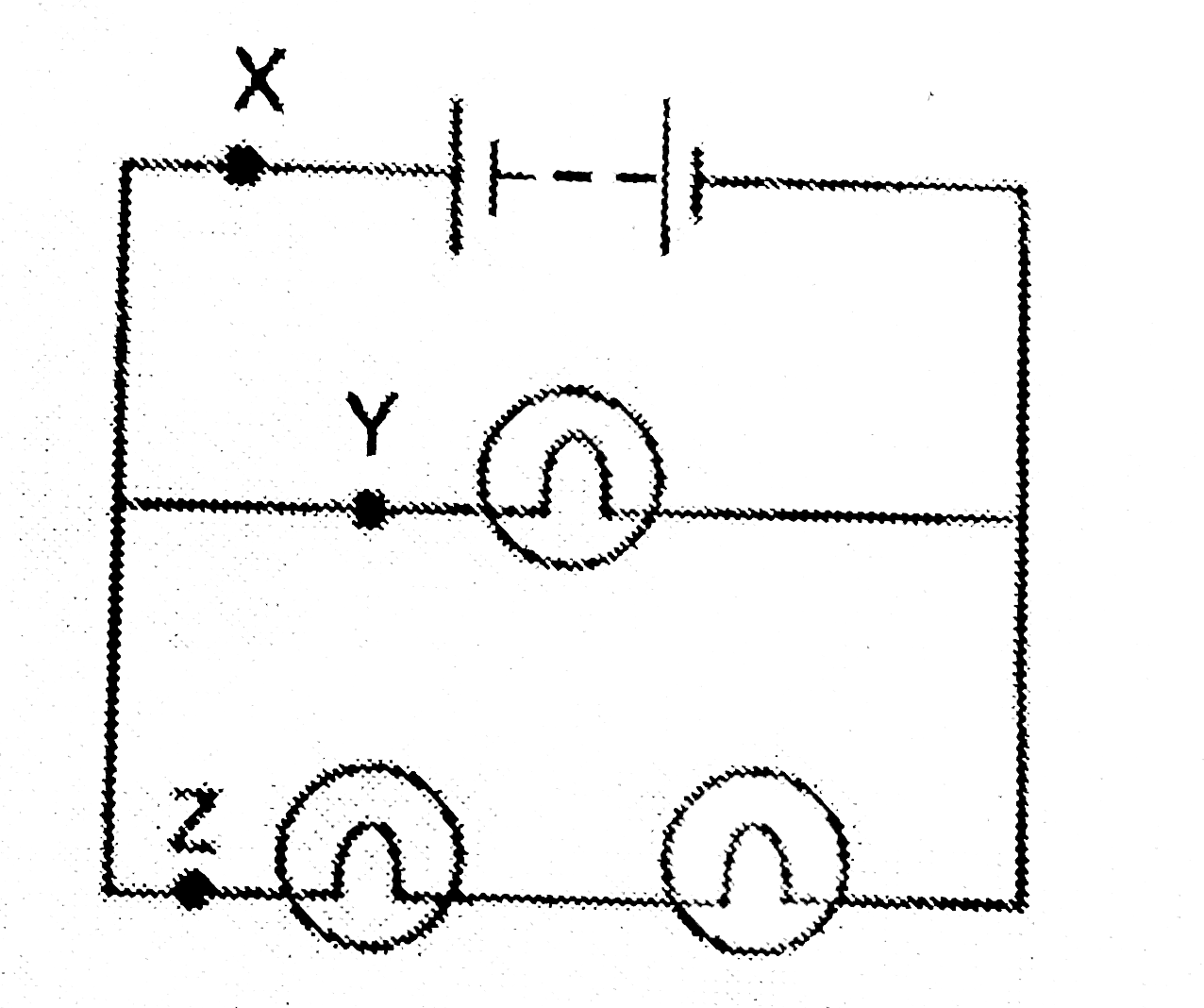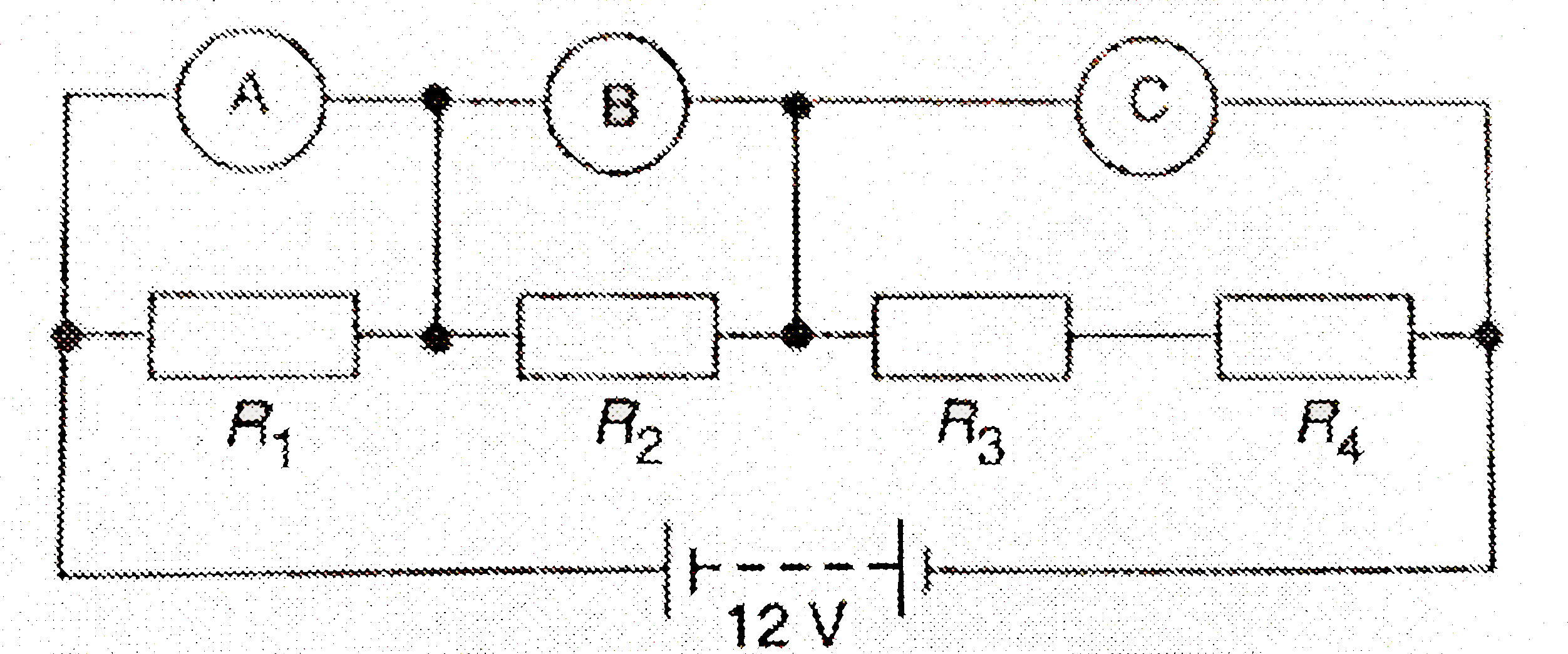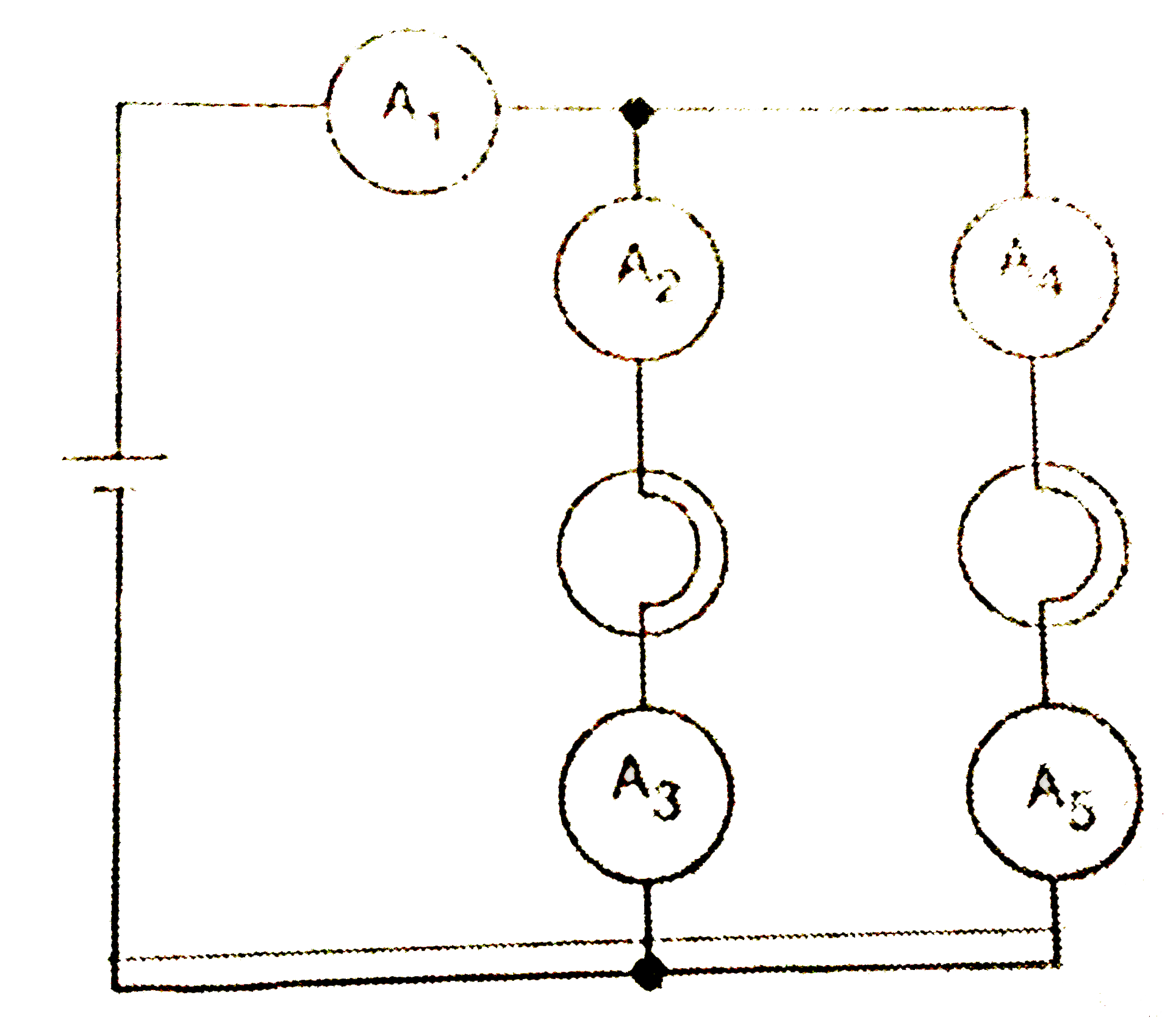Exercise from S CHAND PHYSICS (HINGLISH) ELECTRICITY for Class 10
| Class 10 | PHYSICS |
| Chapter | ELECTRICITY |
| S CHAND PHYSICS (HINGLISH) | Exercise |
| Medium | English |
| Academic Year | 2023-2024 |
Question 14
(a) What do you understand by the term ''potential difference''?
(b) What is meant by saying that the potential difference between two points is 1 volt?
(c) What is the potential difference between the terminals of a battery if 250 joules of work is required to transfer 20 coulombs of charge from one terminal of battery to the other?
(d) What is a voltmeter? How is a voltmeter connected in the circuit to measure the potential difference between two points. Explain with the help of a diagram.
(e) State whether a voltmeter has a high resistance or a low resistance. Give reason for your answer. View SolutionQuestion 47
(a) Define electric current. What is the SI unit of electric current.
(b) One coulomb of charge flows through any cross-section of a conductor in 1 second. What is the current flowing through the conductor?
(c) Which instrument is used to measure electric current? How should it be connected in a circuit?
(d) What is the conventional direction of the flow of electric current? How does it differ from the direction of flow of electrons?
(e) A flash of lightning carries 10C of charge which flows for 0.01s. what is the current? If the voltage is 10MV, what is the energy? View SolutionQuestion 53
A student made an electric circuit shown here to measure the current through two lamps.
(a) Are the lamps in series or parallel?
(b) The student has made a mistake in this circuit. What is the mistake? ,
(c) Draw a circuit diagram to show the correct way to connect the circuit. Use the proper circuit symbols in your diagram.
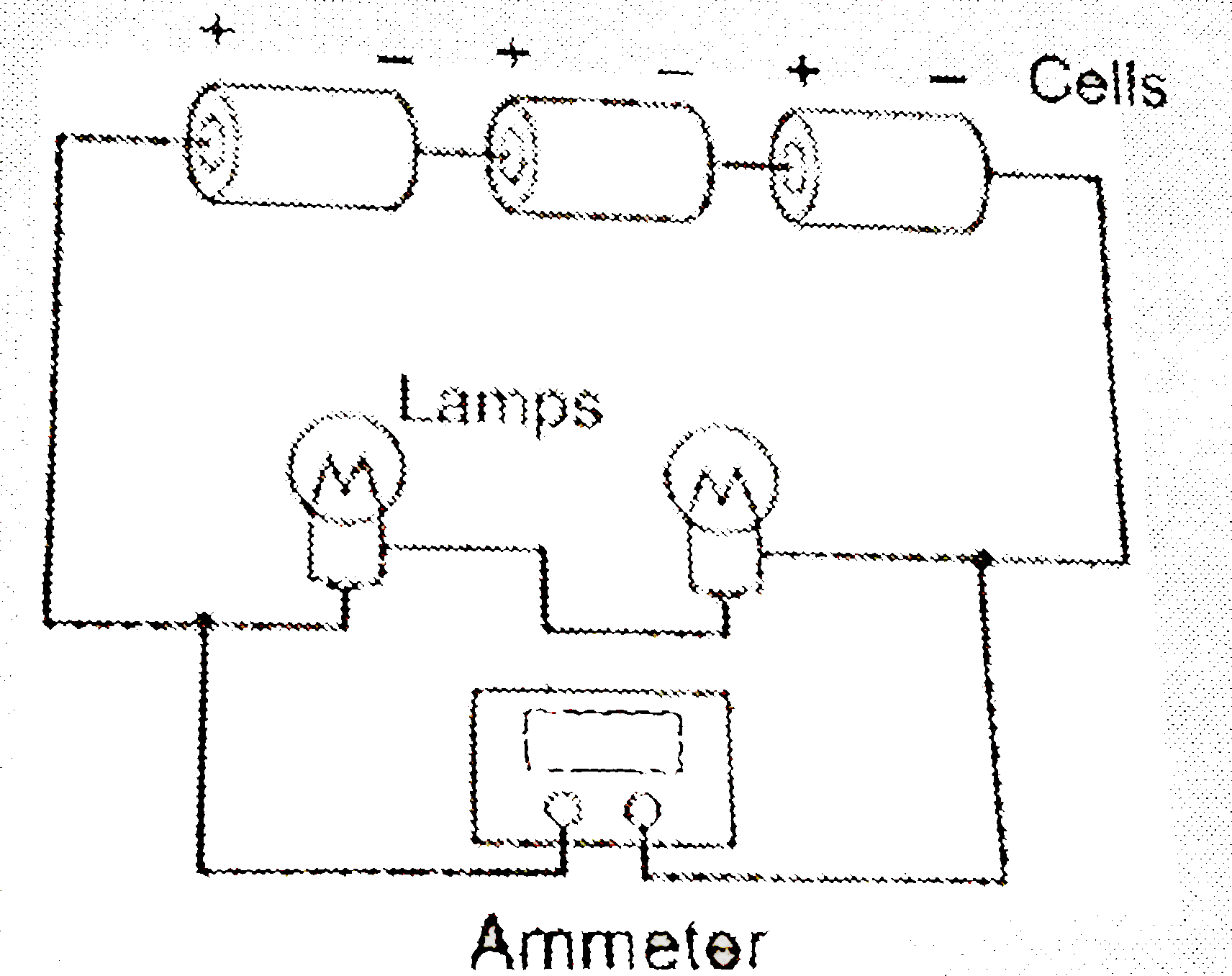 View Solution
View SolutionQuestion 72
(a) What is meant by the ''resistance of a conductor''? Write the relation between resistance, potential difference and current.
(b) When a 12V battery is connected across an unknown resistor, there is a current of 2.5 mA in the circuit. Calculate the value of the resistance of the resistor. View SolutionQuestion 75
(a) Name an instrument that measures electric current in a circuit. Define the unit of electric current.
(b) What do the following symbols, (Fig. 3.58) mean in a circuit diagram ?

(c) An electric circuit consisting of a 0.5m long nichrome wire XY, an ammeter, a voltmeter, four cells of 1.5V each and a plug key was set up.
(i) Draw a diagram of this electric circuit to study the relation between the potential difference maintained between the points X and Y and the electric current flowing through XY.
(ii) Graph shown in (Fig. 3.59) was plotted VandI values.
What would be the values of V/I ratios when the potential differences are 0.8V,1.2Vand1.6V respectively ? What conclusion do you draw from these values ?
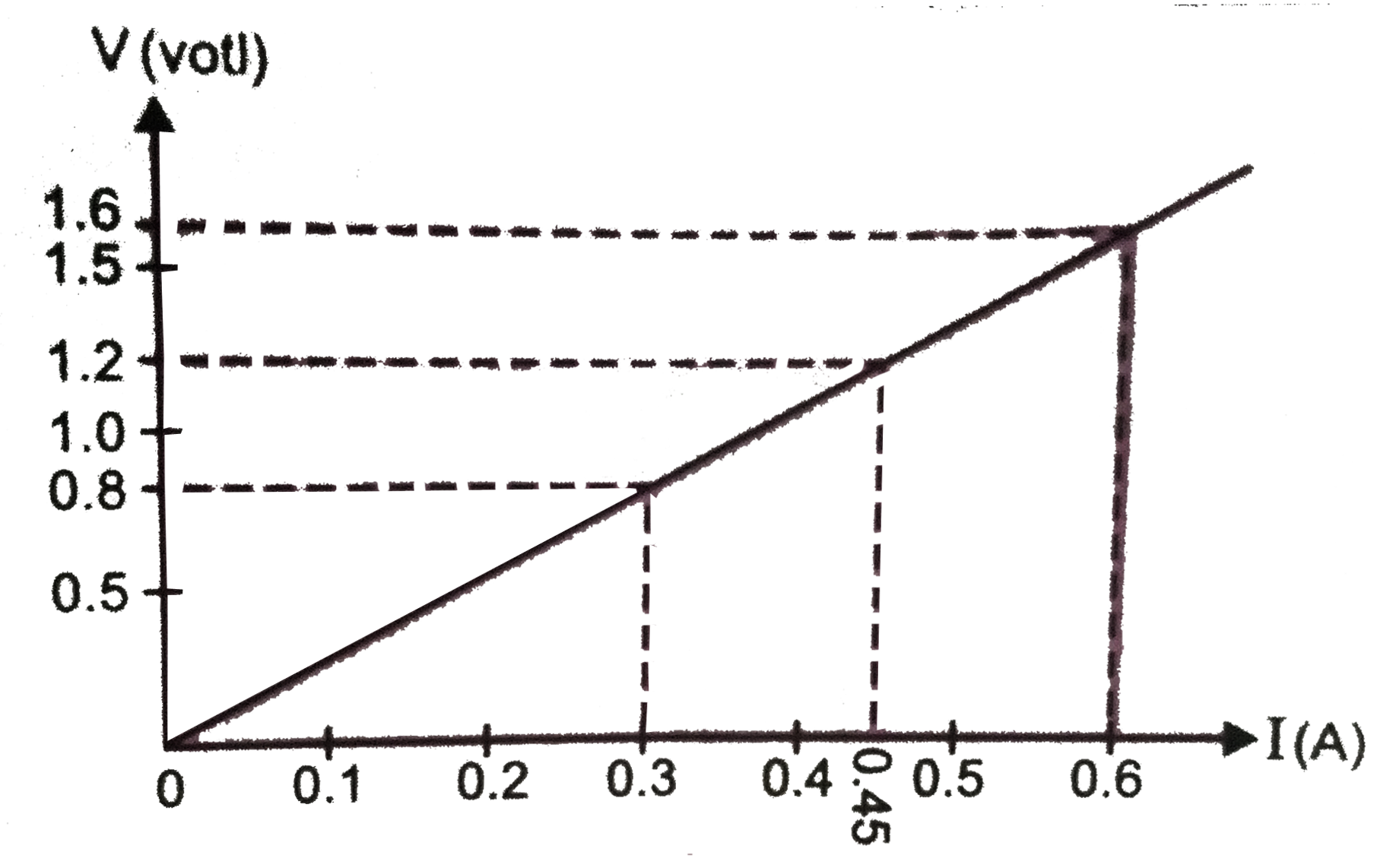 .View Solution
.View SolutionQuestion 76
(a) What is the ratio of potential difference and current known as?
(b) The values of potential difference V applied across a resistor and the corresponding values of current I flowing in the resistor are given below:
Potential differenceV(in volts):2.55.010.015.020.025.0Current,I(in amperes):0.10.20.40.60.81.0
Plot a graph between V and I, and calculate the resistance of the resistor.
(c) Name the law which is illustrated by the above V-I graph.
(d) Write down the formula which states the relations between potential difference, current and resistance.
(d) The potential difference between the terminals of an electric iron is 240V and the current is 5.0A. What is the resistance of the electric iron? View SolutionQuestion 114
(a) Define resistivity. Write an expression for the resistivity of a substance. Give the meaning of each symbol which occurs in it.
(b) State the SI unit of resistivity.
(c) Distinguish between resistance and resistivity.
(d) Name two factors on which the resistivity of a substance depends and two factors on which it does not depend.
(e) The resistance of a metal wire of length 1m is 26Ω at 20∘C. if the diameter of the wire is 0.3mm, what will be the resistivity of the metal at that temperature? View SolutionQuestion 126
The electrical resistivities of five substances A,B,C,D and E are given below:
A5.20×10−8ΩmB110×10−8ΩmC2.60×10−8ΩmD10.0×10−8ΩmE1.70×10−8Ωm
(a) Which substance is the best conductor of electricity? why?
(b) Which one is a better conductor: A or C? Why?
(c) Which substance would you advise to be used for making heating elements of electric irons? Why?
(d) Which two substances should be used for making electric wires? Why? View SolutionQuestion 141
An electric lamp, whose resistance is 20Ω and a conductor of 4Ω resistance are connected to a 6V battery as shown in (Fig. 3.18) Calculate.
(a) the total resistance of the circuit,
(b) the current through the circuit, and
( c) the potential difference across the electric lamp and the conductor.
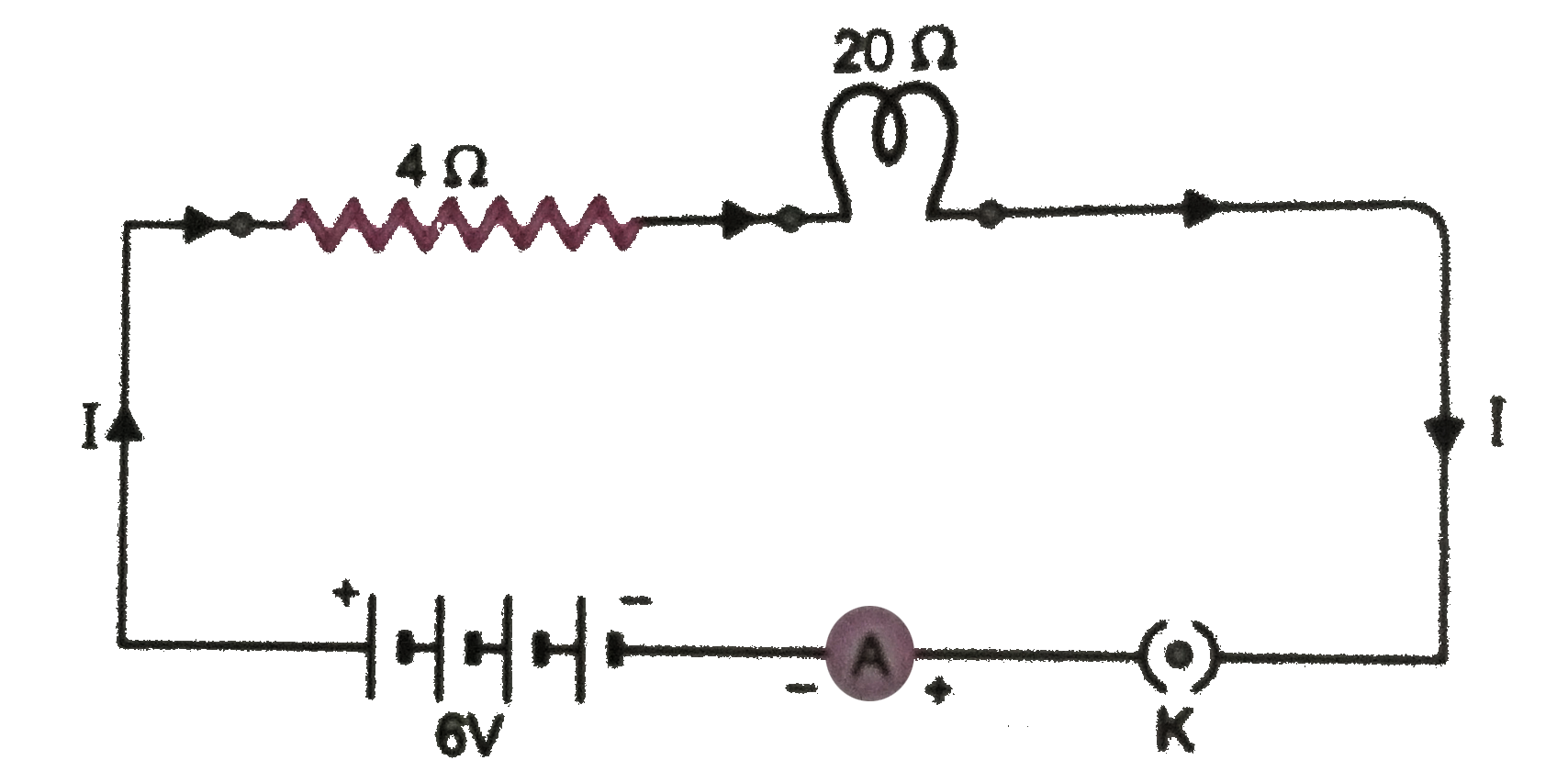 .View Solution
.View SolutionQuestion 144
The resistors, with resistances 5Ω and 10Ω respectively are to be connected to a battery of emf 6V so as to obtain:
(i) minimum current flowing (ii) maximum current flowing
(c) How will you connect the resistances in each case?
(b) Calculate the strength of the total current in the circuit in the two cases. View SolutionQuestion 148
An electric heater which is connected to a 220V supply line has two resistance coils A and B of 24Ω resistance each. These coils be used separately (one at a time), in series or in parallel. Calculate the current drawn when:
(a) only one coil A is used.
(b) coils A and B are used in series.
(c) coils A and B are used in parallel. View SolutionQuestion 155
A 5V battery is connected to two 20Ω resistors which are joined together in series.
(a) Draw a circuit diagram to represent this. Add an arrow to indicate the direction of conventional current flow in the circuit.
(b) What is the effective resistance of two resistors?
(c) Calculate the current that flows from the battery.
(d) What is the p.d. across each resistor? View SolutionQuestion 156
The figure given below shows an electric circuit in which current flows from a 6V battery through two resistors.

(a) Are the resistors connected in series with each other or in parallel?
(b) For each resistor, state the p.d. across it.
(c) The current flowing from the battery is shared between the two resistors. Which resistor will have bigger share of the current?
(d) Calculate the effective resistance of the two resistors.
(e) Calculate the current that flows from the battery. View SolutionQuestion 158
(a) With the help of a circuit diagram, deduce the equivalent resistance of two resistances connected in series.
(b) Two resistances are connected in series as shown in the diagram:
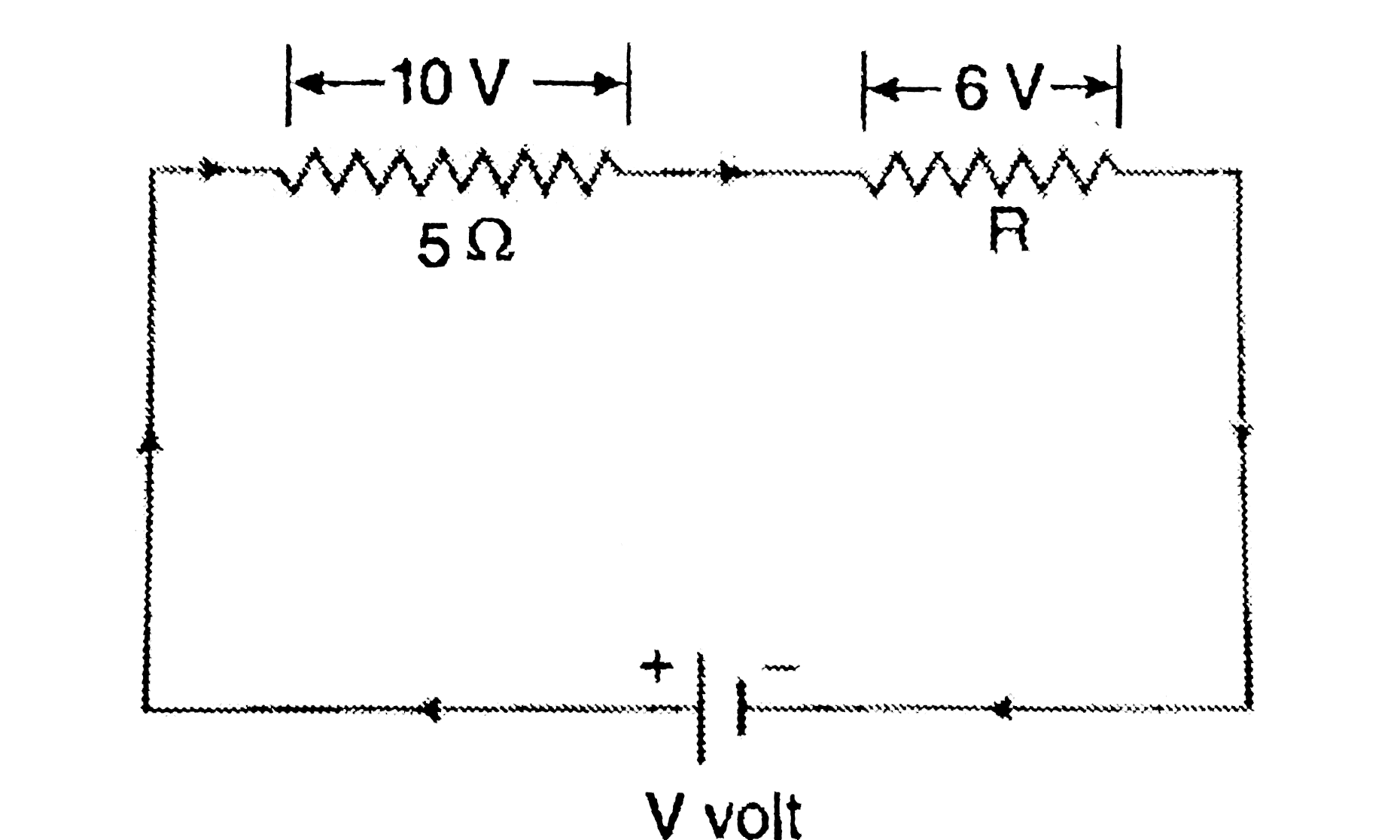
(i) What is the current through the 5 ohm resistance?
(ii) What is the current through R?
(iii) What is the value of R?
(iv) What is the value of V? View SolutionQuestion 159
(a) With the help of a diagram, derive the formula for the resultant resistance of these resistors connected in series.
(b) For the circuit shown in the diagram given below:
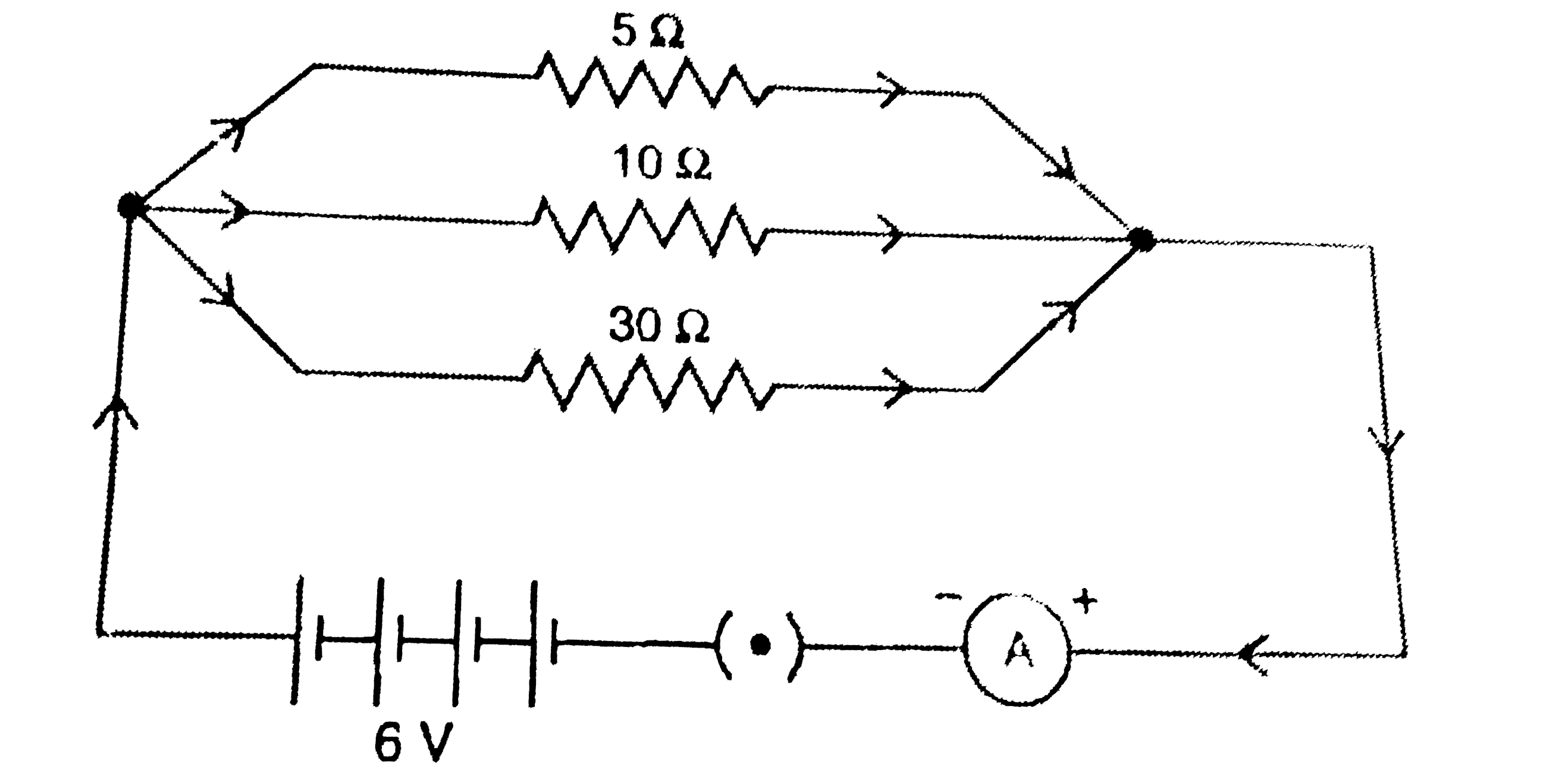
Calculate:
(i) the value of current each resistor.
(ii) the total current in the circuit.
(iii) the total effective resistance of the circuit. View SolutionQuestion 161
(a) Explain with the help of a labelled circuit diagram, how you will find the resistance of a combination of three resistors of resistances R1,R2 and R3 joined in parallel.
(b) In the diagram shown below, the cell and the ammeter both have negligible resistance. The resistors are identical.
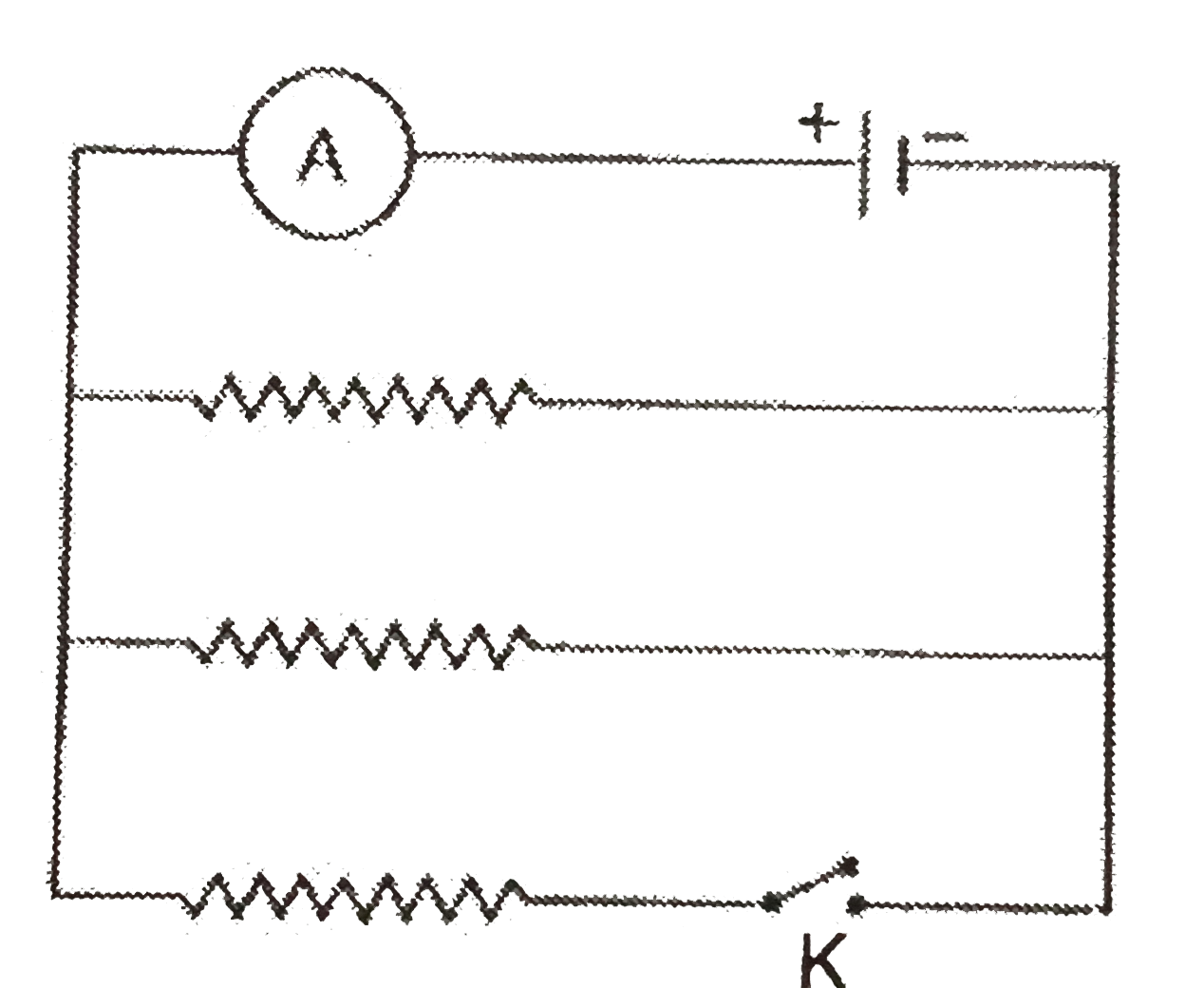
With the switch K open, the ammeter reads 0.6A. What will be the ammeter reading when the switch is closed? View SolutionQuestion 189
Ten bulbs are connected in a series circuit to a power supply line. Ten identical bulbs are connected in a parallel circuit to an identical power supply line.
(a) Which circuit would have the highest voltage across each bulb?
(b) In which circuit would the bulbds be brighter?
(c) In which circuit. if one bulb blows out, all others will stop glowing?
(d) Which circuit would have less current in it? View SolutionQuestion 192
(a) Which is the better way to connect lights and other electrical appliances in domestic wiring: series circuits or parallel circuits? Why?
(b) Christmas tree lamps are usually wired in series. What happens if one lamp breaks?
(c) An electrician has wired a house in such a way that if a lamp gets fused in one room of the house, all the lamps in other rooms of the house stop working. What is the defect in the wiring?
(d) Draw a circuit diagram showing two electric lamps connected in parallel together with a cell and a switch that works both lamps. Mark an A on your diagram to show where an ammeter should be placed to measure the current. View SolutionQuestion 194
Using the circuit given below, state which of the following statemet is correct?
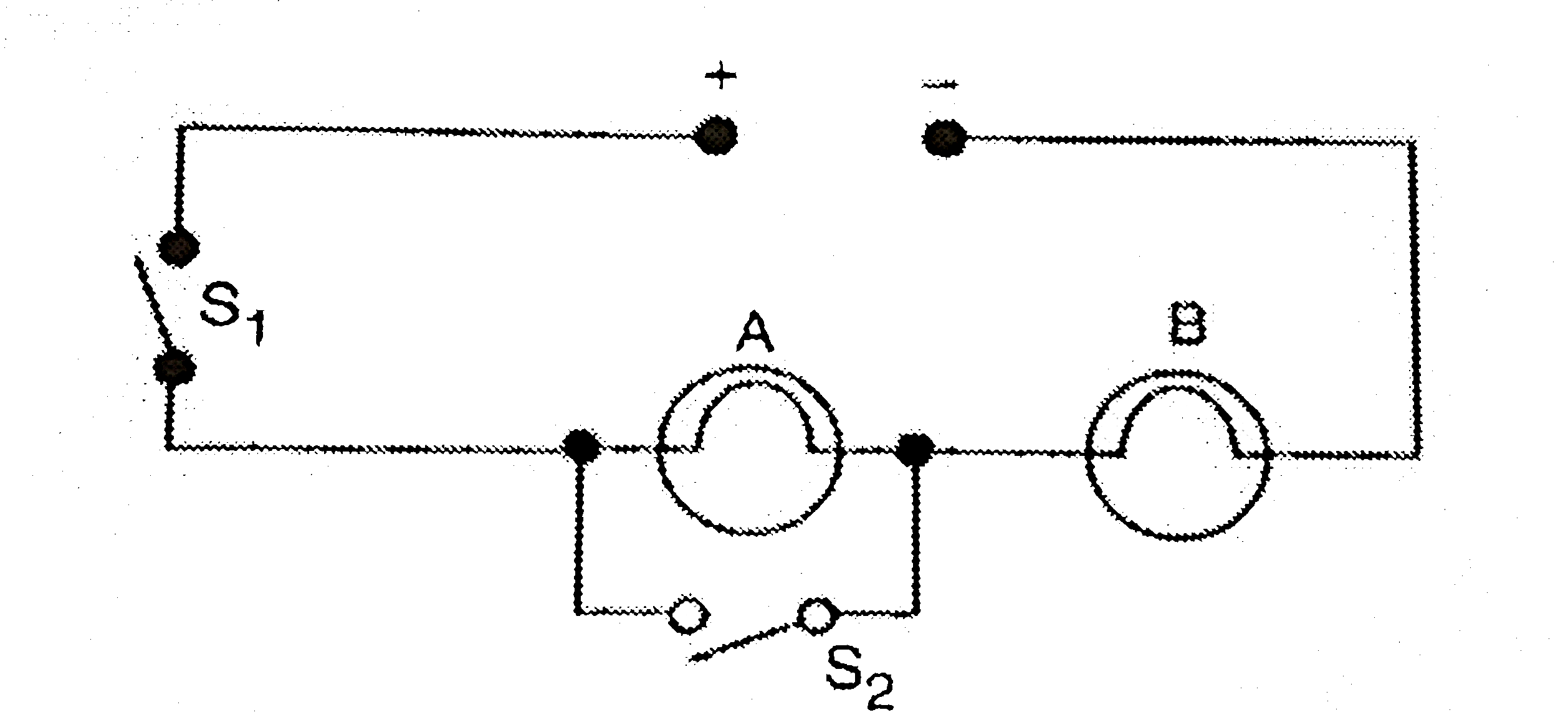
(a) When S1 and S2 are closed, lamps A and B are lit.
(b) With S1 open and S2 closed, A is lit and B is not lit.
(c) With S2 open and S1 closed A and B are lit.
(d) With S1 closed and S2 open, lamp A remains lit even if lamp B gets fused. View SolutionQuestion 196
Consider the circuit given below where A,B and C are three identical light bulbs of constant resistance.

(a) List the bulbs in order of increasing brightness.
(b) If C burns out, what will be the brightness of A now compared with before?
(c) If B burns out instead, what will be the brightness of A and C compared with before? View SolutionQuestion 223
Two lamps, one rated 40W at 220V and the other 60W at 220 V, are connected in parallel to the electric supply at 220V.
(a) Draw a circuit diagram to show the connections.
(b) Calculate the current drawn from the electric supply.
(c) Calculate the total energy consumed by the two lamps together when they operate for one hour. View SolutionQuestion 228
(a) What is meant by "electric power"? Write the formula for electric power in terms of potential difference and current.
(b) The diagram below shows a circuit containing a lamp L, a voltmeter and an ammeter. The voltmeter reading is 3V and the ammeter reading is 0.5A.
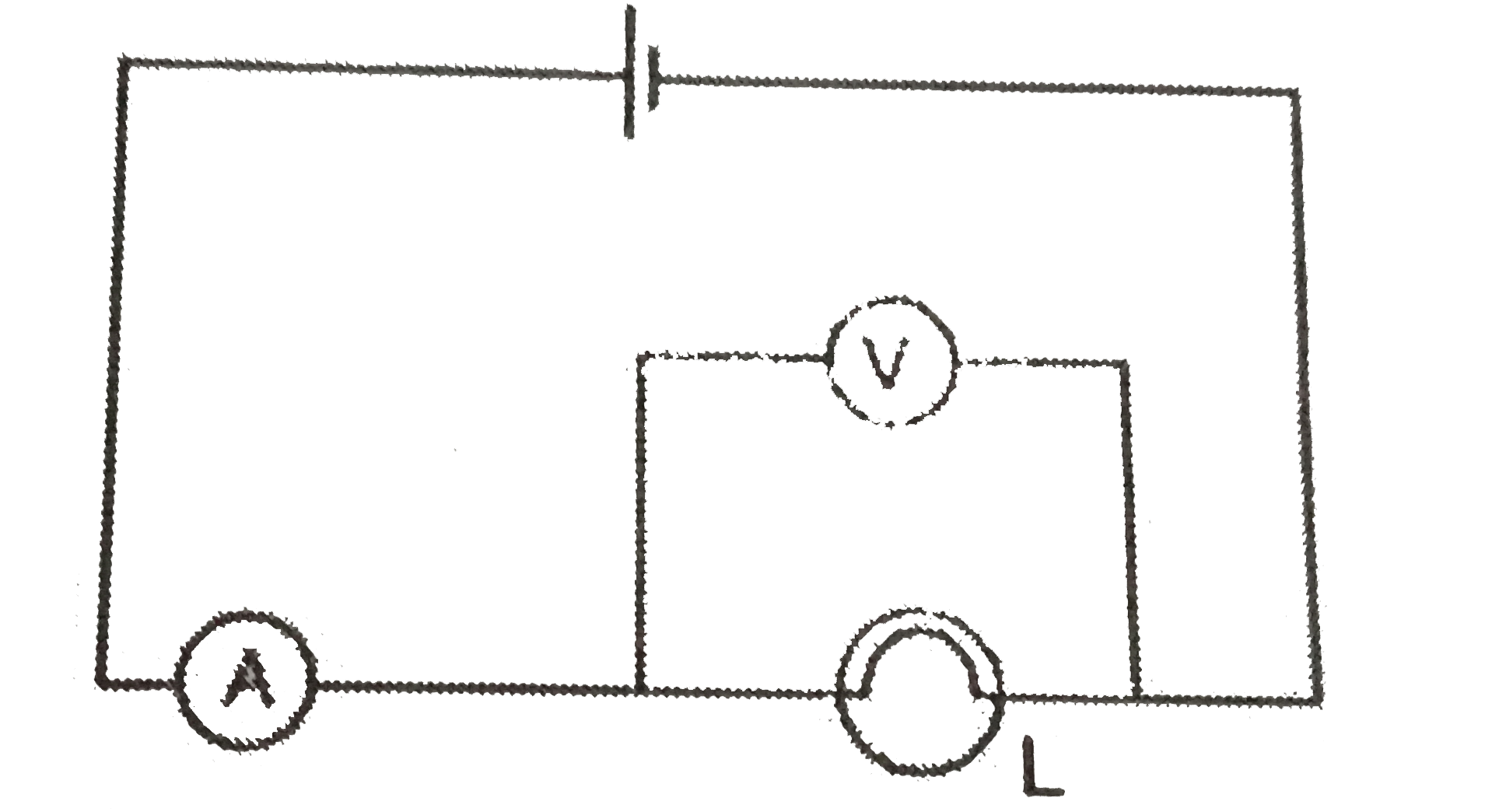
(i) What is the resistance of the lamp?
(ii) What is the power of the lamp?
(c) Define kilowatt-hour. How many joules are there in one kilowatt-hour?
(d) Calculate the cost of operating a heater of 500 W for 20 hours at the rate of Rs 3.90 per unit. View SolutionQuestion 241
The table below shows the current in three different electrical appliances when connected to the 240V mains supply:
ApplianceCurrentKettle8.5ALamp0.4AToaster4.8A
(a) Which appliance has the greatest electrical resistance? How does the data show this?
(b) The lamp is connected to the mains supply by using a thin, twin-cored cable consisting of live and neutral wires. State two reasons why this cable should not be used for connecting the kettle to the mains supply.
(c) Calculate the power rating of the kettle when if is operated from teh 240V mains supply.
(d) A man takes the kettle abroad where the mains supply is 120V. What is the current in the kettle when it is operated from the 120 supply? View SolutionQuestion 242
A boy noted the readings on his home's electricity meter on Sunday at 8AM and again on Monday at 8 AM
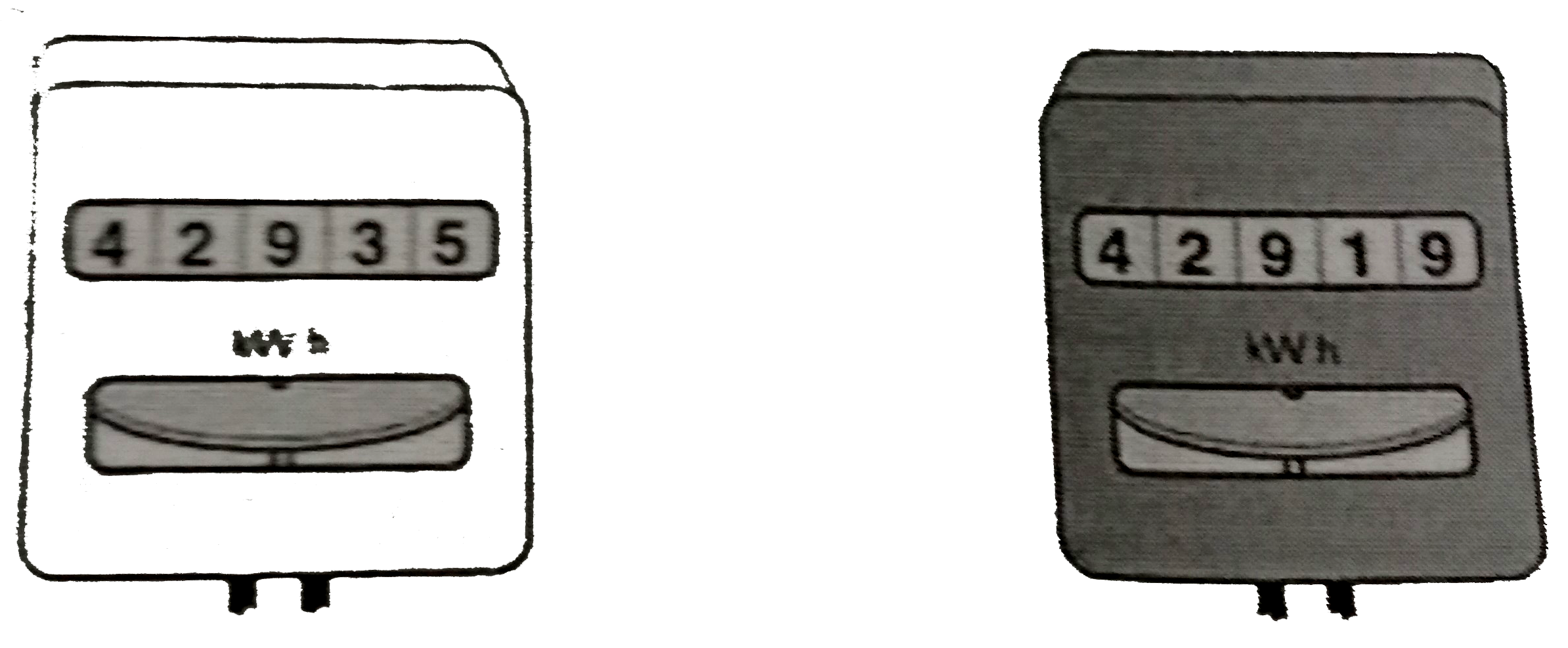
(a) What was the meter reading on Sunday?
(b) What was the meter reading on Monday?
(c) How many units of electricity have been used?
(d) In how much time these units have been used?
(e) If the rate is Rs 5 per unit, what is the cost of electricity used during this time? View SolutionQuestion 263
(a) Derive the expression for the heat produced due to a current 'I' flowing for a time interval 't' through a resistor 'R' having a potential difference 'V' across its ends. With which name is this relation known?
(b) How much heat will an instrument of 12W produce in one minute if its is connected to a battery of 12V?
(c) The current passing through a room heater has been halved. what will happen to the heat produced by it?
(d) What is meant by the heating effect of current? Give two applications of the heating effect of current.
(e) Name the material which is used for making the filaments of an electric bulb.View SolutionQuestion 273
The electrical resistivities of four materials P,Q,R and S are given below:
P6.84×10−8ΩmQ1.70×10−8ΩmR1.0×1015ΩmS11.0×10−7Ωm
Which material will you use for making: (a) heating element of electric iron (b) connecting wire of electric iron (c) covering of connecting wires? Give reason for your choice in each case. View SolutionQuestion 275
Two exactly similar heating resistances are connected (i) in series, and (ii) in parallel, in two different circuits, one by one. If the same current is passed through both the combinations, is more heat obtained per minute when they are connected in series or when they are connected in parallel? Give reason for you answer. View SolutionQuestion 292
An electric lamp of 100Ω, a toaster of resistance 50Ω and a water filter of resistance 500Ω are connected in parallel to a 220V source. What is the resistance of an electric iron connected to the same source that takes as much current as all three appliances and what is the current through it ?View SolutionQuestion 318
Explain the following :
(a) Why is tungsten used almost axclusively for filament of incandescent lamp ?
(b) Why are the conductors of electric heating devices, such as toaster and electric irons, made of an alloy rather than a pure metal ?
( c) Why is the series arrangement not used for domestic circuits ?
(d) How does the resistance of a wire vary with its cross-sectional area ?
(e ) Why are copper and aluminimum wires usually employed for electricity transmission.View Solution



